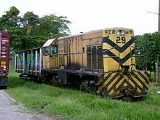
Rail transport in Central America
Encyclopedia

Rail transport
Rail transport is a means of conveyance of passengers and goods by way of wheeled vehicles running on rail tracks. In contrast to road transport, where vehicles merely run on a prepared surface, rail vehicles are also directionally guided by the tracks they run on...
lines with freight or passenger service. The most famous one is Panama Canal Railway, the oldest transcontinental railroad in the world, connecting Panama City
Panama City
Panama is the capital and largest city of the Republic of Panama. It has a population of 880,691, with a total metro population of 1,272,672, and it is located at the Pacific entrance of the Panama Canal, in the province of the same name. The city is the political and administrative center of the...
with Colón
Colón, Panama
Colón is a sea port on the Caribbean Sea coast of Panama. The city lies near the Atlantic entrance to the Panama Canal. It is capital of Panama's Colón Province and has traditionally been known as Panama's second city....
since 1855. Other railroads in Belize
Belize
Belize is a constitutional monarchy and the northernmost country in Central America. Belize has a diverse society, comprising many cultures and languages. Even though Kriol and Spanish are spoken among the population, Belize is the only country in Central America where English is the official...
, Guatemala
Guatemala
Guatemala is a country in Central America bordered by Mexico to the north and west, the Pacific Ocean to the southwest, Belize to the northeast, the Caribbean to the east, and Honduras and El Salvador to the southeast...
, Honduras
Honduras
Honduras is a republic in Central America. It was previously known as Spanish Honduras to differentiate it from British Honduras, which became the modern-day state of Belize...
, El Salvador
El Salvador
El Salvador or simply Salvador is the smallest and the most densely populated country in Central America. The country's capital city and largest city is San Salvador; Santa Ana and San Miguel are also important cultural and commercial centers in the country and in all of Central America...
, Nicaragua
Nicaragua
Nicaragua is the largest country in the Central American American isthmus, bordered by Honduras to the north and Costa Rica to the south. The country is situated between 11 and 14 degrees north of the Equator in the Northern Hemisphere, which places it entirely within the tropics. The Pacific Ocean...
, Costa Rica
Costa Rica
Costa Rica , officially the Republic of Costa Rica is a multilingual, multiethnic and multicultural country in Central America, bordered by Nicaragua to the north, Panama to the southeast, the Pacific Ocean to the west and the Caribbean Sea to the east....
and Panama
Panama
Panama , officially the Republic of Panama , is the southernmost country of Central America. Situated on the isthmus connecting North and South America, it is bordered by Costa Rica to the northwest, Colombia to the southeast, the Caribbean Sea to the north and the Pacific Ocean to the south. The...
were built by private and public investors mainly to facilitate the transport of local agricultural produce (bananas, coconuts, coffee) to export markets and harbors. Their market share and profitability went into decline in the second half of the twentieth century and most lines have been decommissioned by the end of 1990s. As of 2010, railroads operate locally in El Salvador, Honduras, Costa Rica and Panama only; all rail transport has been suspended in Belize, Guatemala and Nicaragua. None of the operating railways crosses national borders.
Belize
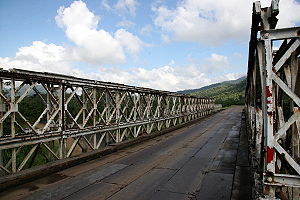
Belize
Belize is a constitutional monarchy and the northernmost country in Central America. Belize has a diverse society, comprising many cultures and languages. Even though Kriol and Spanish are spoken among the population, Belize is the only country in Central America where English is the official...
. Historically, the major line - Stann Creek Railway built by the British Honduras Syndicate and later used by the United Fruit - connected Middlesex Estate with Dangriga
Dangriga
Dangriga, formerly known as Stann Creek Town, is a town in southern Belize, located on the Caribbean coast at the mouth of Stann Creek. It is the capital of Belize's Stann Creek District and also the largest town in southern Belize...
port along present-day Hummingbird Highway
Hummingbird Highway
The Hummingbird Highway is one of the four major highways in Belize. It connects the Western Highway outside of Belmopan, Cayo District with the Southern Highway outside of Dangriga, Stann Creek District. It partially follows, and sometimes uses the infrastructure of, the former Stann Creek Railway...
between 1913 and 1937.
Costa Rica
Railroads in Costa RicaCosta Rica
Costa Rica , officially the Republic of Costa Rica is a multilingual, multiethnic and multicultural country in Central America, bordered by Nicaragua to the north, Panama to the southeast, the Pacific Ocean to the west and the Caribbean Sea to the east....
are managed by state owned Incofer - Instituto Costarricense de Ferrocarriles, and are of narrow gauge (the same as Honduras and Nicaragua). They operate suburban trains around San José
San José, Costa Rica
San José is the capital and largest city of Costa Rica. Located in the Central Valley, San José is the seat of national government, the focal point of political and economic activity, and the major transportation hub of this Central American nation.Founded in 1738 by order of Cabildo de León, San...
and freight trains to the Pacific port of Caldera (outside Puntarenas
Puntarenas
Puntarenas is the capital and largest city in the province Puntarenas, Costa Rica, at the Pacific coast. The eponymous and oddly shaped province has its largest section in the South, far from the capital.Some 100,000 live in the city and close towns...
). A private company, America Travel, organizes weekly tourist trains from San José to Caldera. Additionally, a 3.5 km long tourist "Swiss mountain railroad" with two tunnels runs on the premises of Hotel Los Héroes in Tilarán, Guanacaste Province
Guanacaste Province
Guanacaste is a province of Costa Rica located in the northwestern part of the country, along the coast of the Pacific Ocean. To the north it borders Nicaragua. To the east is the Alajuela Province, and to the southeast is the Puntarenas Province. It is the most sparsely populated of all the...
.
The first railroad in Costa Rica was opened in 1873, running between San José and Alajuela
Alajuela
Alajuela is the second largest city in Costa Rica after the capital, San José. It is also the capital of the namesake province. Because of its location in the Costa Rican Central Valley, Alajuela is nowadays englobed in the conurbation of Great Metropolitan Area...
. In 1890, it reached the Atlantic coast in Puerto Limón. Construction of a Pacific railroad started in 1897 with the first train reaching Puntarenas
Puntarenas
Puntarenas is the capital and largest city in the province Puntarenas, Costa Rica, at the Pacific coast. The eponymous and oddly shaped province has its largest section in the South, far from the capital.Some 100,000 live in the city and close towns...
in 1910. In 1926, a decision was made to electrify the lines; the first electric train reached Puntarenas in 1930.
The railroad network was damaged during an earthquake in 1991 and operation suspended in 1995. After 2000, the state railroad authority (Incofer) works to resume and popularize rail transport again.
As of 2004, the denominated "Tren Interurbano" was reestablished to run services between neighboring cities Heredia and San José (due to the conurbation phenomenon, both cities and in minor extent Alajuela and Cartago, became part of one same urban area known as GAM, Gran Area Metropolitana, Great Metropolitan Area) as well as between Pavas and San Pedro neighborhoods in San José. New Apolo engines imported from Spain should start servicing the route San José - Heredia, several times a day, by the end of April 2009. This transport alternative has received relative widespread acceptance from citizens in GAM to the point that the Government will bid (third quarter, 2009) for the construction and operation of a modern system to operate between Heredia - San José, and San Pedro - Sabana Sur on an initial stage. So far, more than six international companies, specially European, have expressed their interest on the project. Recently a company in Brazil was committed to evaluate the viability of the project and the results were very satisfactory. The Government will provide part of the money needed (based on already existing funds) and the concessionary the rest. The service should be running by 2013.
h
El Salvador
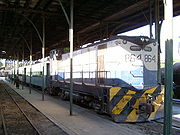
El Salvador
El Salvador or simply Salvador is the smallest and the most densely populated country in Central America. The country's capital city and largest city is San Salvador; Santa Ana and San Miguel are also important cultural and commercial centers in the country and in all of Central America...
has been suspended since October 2002, with the exception of a short-lived shuttle passenger train between San Salvador
San Salvador
The city of San Salvador the capital and largest city of El Salvador, which has been designated a Gamma World City. Its complete name is La Ciudad de Gran San Salvador...
and Soyapango
Soyapango
Soyapango is a municipality in the San Salvador department of El Salvador. Soyapango is a commercial center; it is home to a new modern mall called Plaza Mundo.The municipality is the third most populated area in the country, with 290,412 inhabitants...
during emergency repairs on a road bridge in 2004 - 2005.
In 2007 a suburban passenger service operated by FENADESAL between San Salvador, Ciudad Delgado and Apopa has been put in service, it runs Monday to Friday a round-trip on early morning and another round-trip during evening peak. Its low fare of $0,10 makes it very popular. During 2008 this train transported 224'727 passengers.
Railroads have been built in El Salvador since 1882 by The Salvador Rail Company Limited (later named FES - Ferrocarril de El Salvador) and United Fruit (IRCA). In 1975, the two companies merged into FENADESAL - Ferrocarriles Nacionales de El Salvador. At present, this agency oversees 554.8 km of disused tracks, connecting major cities and formerly linked to Guatemala railroads at Anguiatú. The railroads in El Salvador were of narrow gauge, , the same as Guatemala. The line from Texis Junction to Santa Ana and Ahuachapán has been dismantled and the soil of it given away to people who lost their houses during and earthquake, today it is probably the longest and narrowest slum.
Official homepage: http://www.fenadesal.gob.sv/
Guatemala
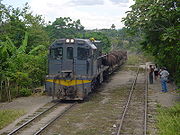
Guatemala
Guatemala is a country in Central America bordered by Mexico to the north and west, the Pacific Ocean to the southwest, Belize to the northeast, the Caribbean to the east, and Honduras and El Salvador to the southeast...
had 200 miles (322 km) of operating narrow gauge railroads between Guatemala City
Guatemala City
Guatemala City , is the capital and largest city of the Republic of Guatemala and Central America...
and Puerto Barrios
Puerto Barrios
Puerto Barrios is a city in Guatemala, located within the Gulf of Honduras at. The bay in which the harbour is located is called Bahia de Amatique. Puerto Barrios is the departmental seat of Izabal department and the administrative seat of Puerto Barrios municipality.Puerto Barrios was named after...
, managed by US-based Railroad Development Corporation as Ferrovías Guatemala. They ran regular freight trains and occasional charter steam trains for tourists from 1999 until September 2007, when all operation was suspended following a conflict with the Government of Guatemala. (June 2011) Most of the rail and steel bridges have now been dismantled by thieves meaning there now no possibility that service can be reinstated without millions of dollars' worth of investment in rebuilding it.
Railroads have been built in Guatemala since 1884. In 1912, the network was acquired by United Fruit Company
United Fruit Company
It had a deep and long-lasting impact on the economic and political development of several Latin American countries. Critics often accused it of exploitative neocolonialism and described it as the archetypal example of the influence of a multinational corporation on the internal politics of the...
, named IRCA and developed to connect Guatemala City with the Pacific coast (Puerto San José
Puerto San José
Puerto San José is a city on Guatemala's Pacific Ocean coast, in the department of Escuintla. It contains about 20,000 people, making it the largest place along the Pacific coast of Guatemala. It was the Pacific port for Guatemala, but this was superseded in the 20th century by Puerto Quetzal, a...
), Atlantic coast (Puerto Barrios
Puerto Barrios
Puerto Barrios is a city in Guatemala, located within the Gulf of Honduras at. The bay in which the harbour is located is called Bahia de Amatique. Puerto Barrios is the departmental seat of Izabal department and the administrative seat of Puerto Barrios municipality.Puerto Barrios was named after...
), El Salvador (Anguiatú), Mexico (Ciudad Tecún Umán - change of gauges
Break-of-gauge
With railways, a break-of-gauge occurs where a line of one gauge meets a line of a different gauge. Trains and rolling stock cannot run through without some form of conversion between gauges, and freight and passengers must otherwise be transloaded...
/) and other places. In 1950s, the railroads went into a decline, resulting in nationalization (1968, new name was FEGUA - Ferrocarriles de Guatemala) and suspension of all services in 1996. In 1997, the government gave a fifty-year concession to the Railroad Development Corporation, which then resumed operations on one line in 1999 and abandoned operation on September 30, 2007.
Apart from this main network, there were two other local railroads - Ferrocarril de Los Altos from Quetzaltenango
Quetzaltenango
Quetzaltenango, also commonly known by its indigenous name, Xelajú , or more commonly, Xela , is the second largest city of Guatemala. It is both the capital of Quetzaltenango Department and the municipal seat of Quetzaltenango municipality....
to Retalhuleu
Retalhuleu
The city of Retalhuleu is in south-western Guatemala. It is the departmental seat of Retalhuleu department as well as the municipal seat of Retalhuleu municipality....
and Ferrocarril Verapaz to the North-West of Lago de Izabal. They were closed in 1933 and 1963, respectively.
Honduras
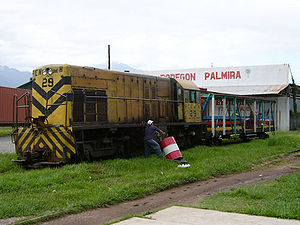
Honduras
Honduras is a republic in Central America. It was previously known as Spanish Honduras to differentiate it from British Honduras, which became the modern-day state of Belize...
have been built in the northern lowlands (Valle de Sula) since 1880s by two competing banana growers - United Fruit and Standard Fruit. They never extended to the capital (Tegucigalpa
Tegucigalpa
Tegucigalpa , and commonly referred as Tegus , is the capital of Honduras and seat of government of the Republic, along with its twin sister Comayagüela. Founded on September 29, 1578 by the Spanish, it became the country's capital on October 30, 1880 under President Marco Aurelio Soto...
) or to the Pacific coast and never linked to other countries. In 1993, the combined network had 785 km. All railroads in Honduras are . In 2006, three separate segments operated under the management of FNH - Ferrocarril Nacional de Honduras:
- San Pedro SulaSan Pedro SulaSan Pedro Sula is a city in Honduras. It is located in the northwest corner of the country, in the Valle de Sula , about 60 km south of Puerto Cortés on the Caribbean. With an estimated population of 638,259 people in the main municipality, and 802,598 in its metro area , it is the second...
- Puerto CortesPuerto Cortés-Geography:It is on the Caribbean Sea coast, north of San Pedro Sula and east of Omoa, at 15.85° N, 87.94° W. It has a natural bay.It is Honduras's main sea port and it is considered the most important seaport in Central America...
(50 km, freight trains carrying mainly lumber) and occasional passenger trains around San Pedro Sula, for example during carneval and other holidays. - City rail in La CeibaLa CeibaLa Ceiba is a port city on the northern coast of Honduras in Central America. It is located on the southern edge of the Caribbean, forming part of the south eastern boundary of the Gulf of Honduras...
(3 km, passenger transport between downtown and a western suburb, Col. Sitramacsa) - Line between La UniónLa Unión, HondurasLa Unión is a municipality in the Honduran department of Copán....
and Parque Nacional Cuero y Salado (9 km, transport of coconuts to a processing plant and of tourists to national park)
Nicaragua
There are no operating railroads in NicaraguaNicaragua
Nicaragua is the largest country in the Central American American isthmus, bordered by Honduras to the north and Costa Rica to the south. The country is situated between 11 and 14 degrees north of the Equator in the Northern Hemisphere, which places it entirely within the tropics. The Pacific Ocean...
. The majority of lines were closed in 1993, the last one in 2001.
Narrow gauge railroads in Nicaragua have been built since 1878 on the Pacific coast. First was a Western division (from Corinto to Puerto Momotombo at Lake Managua
Lake Managua
Lake Managua is a lake in Nicaragua. The Spanish name is Lago de Managua or Lago Xolotlán. At 1,042 km², it is approximately long and wide. Similarly to the name of Lake Nicaragua, its name was coined by the Spanish conquerors from "Mangue" and agua...
, passengers to Managua had to change to a steamboat), then the Eastern division from Managua
Managua
Managua is the capital city of Nicaragua as well as the department and municipality by the same name. It is the largest city in Nicaragua in terms of population and geographic size. Located on the southwestern shore of Lake Xolotlán or Lake Managua, the city was declared the national capital in...
to Granada
Granada
Granada is a city and the capital of the province of Granada, in the autonomous community of Andalusia, Spain. Granada is located at the foot of the Sierra Nevada mountains, at the confluence of three rivers, the Beiro, the Darro and the Genil. It sits at an elevation of 738 metres above sea...
and finally a Central division connecting these two (thus eliminating the need for steamboats). In the following years, several branch lines were built. There were attempts to connect both coasts, but they all failed; except for a few isolated lines in the North, almost all of the network was in the Pacific basin. In 1993, there were 373 km of narrow gauge tracks in the Pacific region and isolated 3 km of standard gauge
Standard gauge
The standard gauge is a widely-used track gauge . Approximately 60% of the world's existing railway lines are built to this gauge...
line at Puerto Cabezas
Puerto Cabezas
Puerto Cabezas is a municipality in, and capital of, the North Atlantic Coast department of Nicaragua....
in the Caribbean. Most lines were shut down on December 31, 1993. The last one - 6 km from Chichigalpa
Chichigalpa
Chichigalpa is a town and municipality in the Chinandega Department of Nicaragua.-Pre-Columbian:It is presumed that Chichigalpa's first inhabitants arrived from the north. While their civilizations were not as advanced as those of the Aztecs and the Incans, they arrived at Chichigalpa due to a...
to Ing. S. Antonio - was decommissioned in September 2001.
Panama

Panama
Panama , officially the Republic of Panama , is the southernmost country of Central America. Situated on the isthmus connecting North and South America, it is bordered by Costa Rica to the northwest, Colombia to the southeast, the Caribbean Sea to the north and the Pacific Ocean to the south. The...
is Panama Railway
Panama Railway
The Panama Canal Railway Company is a railway line that links the Atlantic Ocean to the Pacific Ocean across Panama in Central America. It is jointly owned by the Kansas City Southern Railway and Mi-Jack Products...
- the oldest intercontinental railway in the world, connecting Panama City
Panama City
Panama is the capital and largest city of the Republic of Panama. It has a population of 880,691, with a total metro population of 1,272,672, and it is located at the Pacific entrance of the Panama Canal, in the province of the same name. The city is the political and administrative center of the...
and Colón
Colón, Panama
Colón is a sea port on the Caribbean Sea coast of Panama. The city lies near the Atlantic entrance to the Panama Canal. It is capital of Panama's Colón Province and has traditionally been known as Panama's second city....
with passenger and freight trains since 1855. It provided a vital transport link between the eastern United States and California during the mid 19th century and was used for the construction of Panama Canal
Panama Canal
The Panama Canal is a ship canal in Panama that joins the Atlantic Ocean and the Pacific Ocean and is a key conduit for international maritime trade. Built from 1904 to 1914, the canal has seen annual traffic rise from about 1,000 ships early on to 14,702 vessels measuring a total of 309.6...
. In 1979, the US transferred control of the railroad to Panama; in 1998, it was privatized and since 2000, it runs on standard gauge
Standard gauge
The standard gauge is a widely-used track gauge . Approximately 60% of the world's existing railway lines are built to this gauge...
. Prior to that it ran on broad gauge
Broad gauge
Broad-gauge railways use a track gauge greater than the standard gauge of .- List :For list see: List of broad gauges, by gauge and country- History :...
.
At the end of the nineteenth century, the government of Panama studied the feasibility of additional railroads. Panama Railway was commissioned to estimate the cost of a railroad from Panama City to David, Chiriquí
David, Panama
David is a city located in the west of Panama. It is the capital of the province of Chiriquí and has an estimated population of 144,858 inhabitants as confirmed in 2010. It is a relatively affluent city with most families and houses having basic living requirements, such as concrete houses, clean...
. The cost was however too high and a decision was made, to build additional network in Chiriquí Province
Chiriquí Province
Chiriquí is a province of Panama, it is located on the western coast of Panama, and it is also the second most developed province in the country, after the Panamá Province. Its capital is the city of David. It has a total area of 6,490.9 km², with a population of 416,873 as of the year 2010...
only. This railroad (Ferrocarril de Chiriquí) was inaugurated on April 23, 1916 with the first train on a steep mountain line from David to Boquete. Additional lines were built subsequently. After 1974, the infrastructure of Chiriquí Railroads has been transferred to Ministry of Public Works (Ministerio de Obras Públicas) and operations were stopped line by line. The last regular passenger service operated twice daily with a railcar between Ciudad David and Puerto Armuelles in about 1984. In the beginning of the 21st century, the tracks of the defunct railroads are being dismantled and reused for construction of bridges in rural areas. The Bocas Division of the Ferrocarril de Chiriquí, on the Atlantic coast and close to the border with Costa Rica, was operating on some parts until early 2009, when the remaining lines have been closed and dismantled.
Two separate and distinct tram
Tram
A tram is a passenger rail vehicle which runs on tracks along public urban streets and also sometimes on separate rights of way. It may also run between cities and/or towns , and/or partially grade separated even in the cities...
or streetcar systems operated in Panama City
Panama City
Panama is the capital and largest city of the Republic of Panama. It has a population of 880,691, with a total metro population of 1,272,672, and it is located at the Pacific entrance of the Panama Canal, in the province of the same name. The city is the political and administrative center of the...
. The first started service on October 1, 1893 and ended during the Thousand Days' War. The second started in 1913 and operated, with reorganizations and company transferrals, until May 31, 1941.
FERISTSA
The FERISTSAFERISTSA
FERISTSA was the name of a proposed USD $3 billion privately owned commercial railroad going from the Panama Canal Railway Company through the entire length of Central America, linking with Mexico's rail system at the Guatemala border, and thus to the United States of America.- Description :The...
Railway was proposed to connect Mexico with Panama via ports along the way.

